商务谈判技巧英文
国际商务谈判(英文)chapter8 Communication Skills in International Business Negotiation[精]
![国际商务谈判(英文)chapter8 Communication Skills in International Business Negotiation[精]](https://img.taocdn.com/s3/m/896129541ed9ad51f01df28f.png)
8.2 Skills of talking
8.2.1 Negotiation language
Your presentation should be executed in all attractive manner that is pleasing,not offensive.It should be fair and consider the pros and cons,not suspicious.It should be cooperative and friendly,not argumentative or hostile.It should emphasize the positive,not the negative, stress the familiar,not the unknown,and be democratic,not dictatorial.Your presentation should be understated,not exaggerated.
17
Hale Waihona Puke 8.3.2 When to ask
(1) It is premise to listen attentively to the other party.
(2) Don’t ask casually, and watch chance. (3) Don’t eager to raise questions before the
11
8.2.3Practical tips for making statements
(5) Try to be objective and genuine. (6)Have a sense of propriety in speech or
商务谈判对话英文版
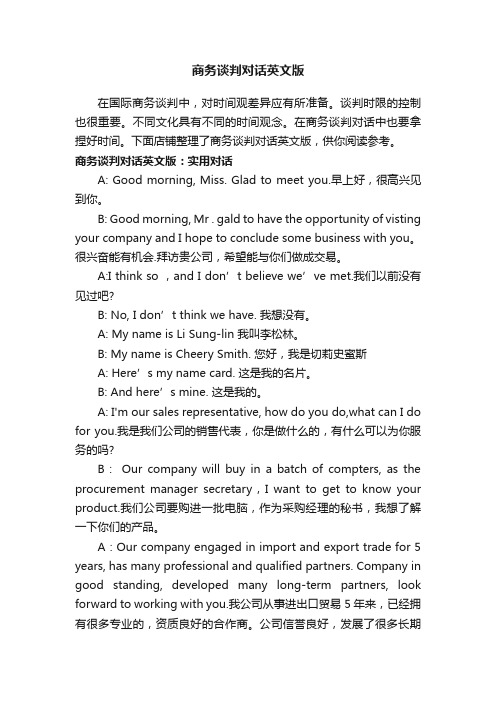
商务谈判对话英文版在国际商务谈判中,对时间观差异应有所准备。
谈判时限的控制也很重要。
不同文化具有不同的时间观念。
在商务谈判对话中也要拿捏好时间。
下面店铺整理了商务谈判对话英文版,供你阅读参考。
商务谈判对话英文版:实用对话A: Good morning, Miss. Glad to meet you.早上好,很高兴见到你。
B: Good morning, Mr . gald to have the opportunity of visting your company and I hope to conclude some business with you。
很兴奋能有机会.拜访贵公司,希望能与你们做成交易。
A:I think so ,and I don’t believe we’ve met.我们以前没有见过吧?B: No, I don’t think we have. 我想没有。
A: My name is Li Sung-lin 我叫李松林。
B: My name is Cheery Smith. 您好,我是切莉史蜜斯A: Here’s my name card. 这是我的名片。
B: And here’s mine. 这是我的。
A: I'm our sales representative, how do you do,what can I do for you.我是我们公司的销售代表,你是做什么的,有什么可以为你服务的吗?B:Our company will buy in a batch of compters, as the procurement manager secretary,I want to get to know your product.我们公司要购进一批电脑,作为采购经理的秘书,我想了解一下你们的产品。
A:Our company engaged in import and export trade for 5 years, has many professional and qualified partners. Company in good standing, developed many long-term partners, look forward to working with you.我公司从事进出口贸易5年来,已经拥有很多专业的,资质良好的合作商。
商务谈判战略技巧英文版
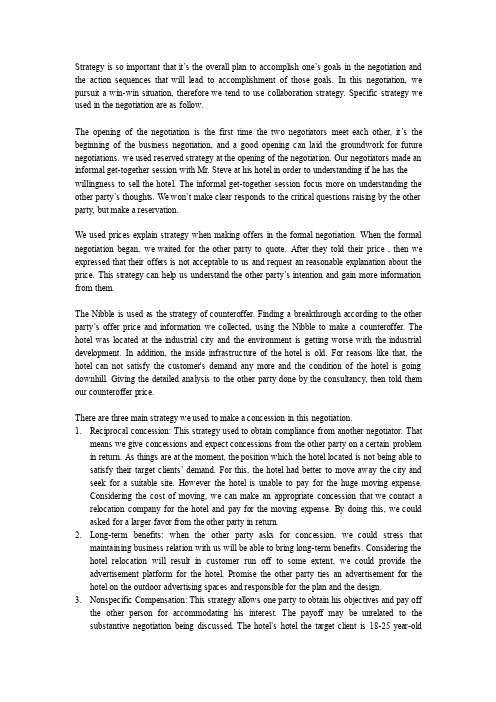
Strategy is so important that it’s the overall plan to accomplish one’s goals in the negotiation and the action sequences that will lead to accomplishment of those goals. In this negotiation, we pursuit a win-win situation, therefore we tend to use collaboration strategy. Specific strategy we used in the negotiation are as follow.The opening of the negotiation is the first time the two negotiators meet each other, it’s the beginning of the business negotiation, and a good opening can laid the groundwork for future negotiations. we used reserved strategy at the opening of the negotiation. Our negotiators made an informal get-together session with Mr. Steve at his hotel in order to understanding if he has the willingness to sell the hotel. The informal get-together session focus more on understanding the other party’s thoughts. We won’t make clear responds to the critical questions raising by the other party, but make a reservation.We used prices explain strategy when making offers in the formal negotiation. When the formal negotiation began, we waited for the other party to quote. After they told their price , then we expressed that their offers is not acceptable to us and request an reasonable explanation about the price. This strategy can help us understand the other party’s intention and gain more information from them.The Nibble is used as the strategy of counteroffer. Finding a breakthrough according to the other party’s offer price and information we collected, using the Nibble to make a counteroffer. The hotel was located at the industrial city and the environment is getting worse with the industrial development. In addition, the inside infrastructure of the hotel is old. For reasons like that, the hotel can not satisfy the customer's demand any more and the condition of the hotel is going downhill. Giving the detailed analysis to the other party done by the consultancy, then told them our counteroffer price.There are three main strategy we used to make a concession in this negotiation.1.Reciprocal concession: This strategy used to obtain compliance from another negotiator. Thatmeans we give concessions and expect concessions from the other party on a certain problem in return. As things are at the moment, the position which the hotel located is not being able to satisfy their target clients’ demand. For this, the hotel had better to move away the city and seek for a suitable site. However the hotel is unable to pay for the huge moving expense.Considering the cost of moving, we can make an appropriate concession that we contact a relocation company for the hotel and pay for the moving expense. By doing this, we could asked for a larger favor from the other party in return.2.Long-term benefits: when the other party asks for concession, we could stress thatmaintaining business relation with us will be able to bring long-term benefits. Considering the hotel relocation will result in customer run off to some extent, we could provide the advertisement platform for the hotel. Promise the other party ties an advertisement for the hotel on the outdoor advertising spaces and responsible for the plan and the design.3.Nonspecific Compensation: This strategy allows one party to obtain his objectives and pay offthe other person for accommodating his interest. The payoff may be unrelated to the substantive negotiation being discussed. The hotel’s hotel the target client is 18-25 year-oldyoung student whose paying capacity is low. We respect the spirit that the hotel founders always care of the s minority groups of the society. For this, our company would like to donate 20,000 dollars to aid by establishing a fund for hotelFour main options that we could used in this negotiation for responding to the other party’s offensive.1.Respond in kind: ask for some benefits from the other party before we make concession.When the other party insist on a certain problem and force us to make concession, we could relate this question with other questions together, for the condition to make concession If the other party requests us to raise the price, we could agree it only the when the hotel promise to move within a month. Our company could start our construction as soon as possible if the hotel moves in the in a short time.2.Adjournment: When there is an obstruction in the negotiation, using adjournment couldeffective. When the other party put forward a price that we could not accept it and they showing no willingness to make a concession, then we could call for an adjournment. That could make us analyze the situation objectively, and take the corresponding countermeasure.3.No precedent :that’s a strategy to reject the other party’s request. When the other party makean extortionate request, we could explain to them that our company had no this precedent in the past and it’s un fair to other clients. By using this strategy to protect our own interest.4.Power limitation: During the negotiation ,when the other party asked for price that is close to290,000, our negotiators could indicated that they have no right the decision-making , that have already outrun the power range that they have to ask for instruction from superior.。
国际商务谈判英文版PPT-8 . Negotiation Strategies

• the ability to develop effective negotiation strat egies is improved if a negotiating team already has clear, specific goals – and knows what the goals of the other team are
• Managers who participate in international business n egotiations must be flexible enough to convert probl ems into opportunities
• Managers demonstrate their flexibility in the course o f a negotiation by being willing to re-evaluate and ref ormulate strategies which are turning out to be inapp ropriate
International Business Negotiation
Principles and Practice
8 Negotiation Strategies
Overview
• STRATEGY IN NEGOTIATIONS • STRATEGIC ORIENTATIONS • MAXIMUM GAIN STRATEGIES • NEGOTIATING TACTICS
t of a certain price range or profit level – a supply contract with a potential foreign partner – access to a foreign partner’s technology
商务谈判英文模拟对话_谈判技巧_
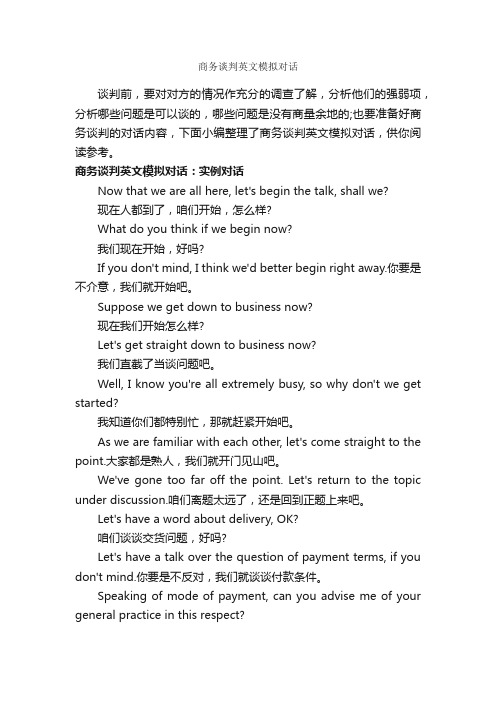
商务谈判英文模拟对话谈判前,要对对方的情况作充分的调查了解,分析他们的强弱项,分析哪些问题是可以谈的,哪些问题是没有商量余地的;也要准备好商务谈判的对话内容,下面小编整理了商务谈判英文模拟对话,供你阅读参考。
商务谈判英文模拟对话:实例对话Now that we are all here, let's begin the talk, shall we?现在人都到了,咱们开始,怎么样?What do you think if we begin now?我们现在开始,好吗?If you don't mind, I think we'd better begin right away.你要是不介意,我们就开始吧。
Suppose we get down to business now?现在我们开始怎么样?Let's get straight down to business now?我们直截了当谈问题吧。
Well, I know you're all extremely busy, so why don't we get started?我知道你们都特别忙,那就赶紧开始吧。
As we are familiar with each other, let's come straight to the point.大家都是熟人,我们就开门见山吧。
We've gone too far off the point. Let's return to the topic under discussion.咱们离题太远了,还是回到正题上来吧。
Let's have a word about delivery, OK?咱们谈谈交货问题,好吗?Let's have a talk over the question of payment terms, if you don't mind.你要是不反对,我们就谈谈付款条件。
卖方商务谈判方案英文版
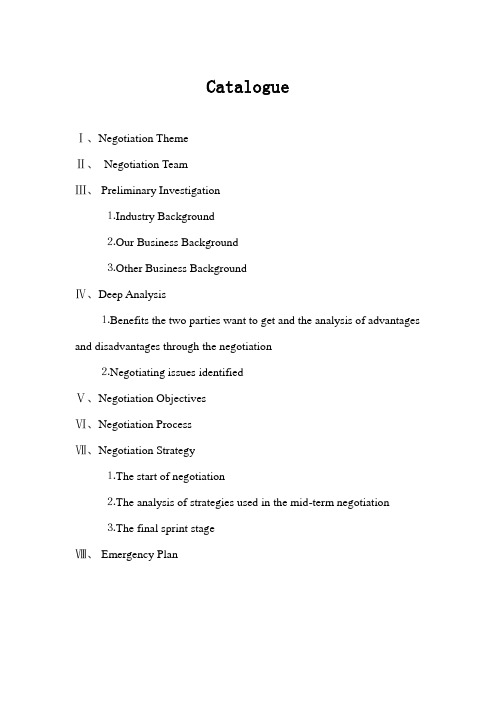
CatalogueⅠ、Negotiation ThemeⅡ、Negotiation TeamⅢ、 Preliminary Investigation⒈Industry Background⒉Our Business Background⒊Other Business BackgroundⅣ、Deep Analysis⒈Benefits the two parties want to get and the analysis of advantages and disadvantages through the negotiation⒉Negotiating issues identifiedⅤ、Negotiation ObjectivesⅥ、Negotiation ProcessⅦ、Negotiation Strategy⒈The start of negotiation⒉The analysis of strategies used in the mid-term negotiation⒊The final sprint stageⅧ、 Emergency PlanNegotiation matters with the British Lipton on tea wholesale Ⅰ、Negotiation ThemeThe negotiating cooperation around the central theme of tea procurement will be launched by the exchange of feelings to achieve peace negotiations and show our sincerity. We hope that both sides can reach a win-win situation over the negotiations through the exchange, and achieve the long-term cooperation in the future .Ⅱ、Negotiation TeamOur company:Chief negotiator: Yang Miaomiao (responsible for the negotiation matters on tea wholesale )Auxiliary negotiator: Chen Cong ( negotiation assistant)British Lipton:Chief negotiator: He Yanjiiao (marketing director)Auxiliary negotiator: Liu Xiaofei (Financial Officer)Ⅲ、 Preliminary Investigation⒈Industry BackgroundDomestic background of tea market: At present, China's tea production, domestic sales, tea exports are at best level in history,mainly due to the financial support from local government , the deepening reform of tea enterprise, the new capital and the new technology widely used in tea production, as well as the development of new tea products, which have injected new vitality into tea industry in China.British background of tea market : Nowadays,UK is the largest tea importer around the world. Britons are world-renowned as the person who enjoy drinking tea with the consumption of 160 million cups of tea per day. The tea they import from other countries are most of bulk tea , which is made through blending, packaging (small packages) or processed into a teabag after entering into the market. Britons pay more attention on the high quality of tea. Tea-drinking is deeply rooted in the British tea culture and usually in high-end consumer-oriented with a great variety of tea,which could be divided into Ceylon tea, Earl Grey, English breakfast tea, Irish breakfast tea and organic tea. In recent years, due to the strong growth of tea trade on green tea, Darjeeling tea, fruit tea, herbal tea and some other new varieties of tea, overall sales in the UK tea market decreased slowly. At this point, in order to maintain market share, the original merchants must introduce new varieties and seize new opportunities to develop tea markets.⒉Our Business BackgroundFujian Tea Import & Export Co., Ltd. is a foreign trade company held by China Tea Co., Ltd., which is under China National Cereals, Oils and Foodstuffs Corp. (COFCO). Established in February, 1950, our company has developed a business mode, led by foreign trade and integrated by agriculture, industry and trade. Our mission is to promote Chinese tea, pioneer Fujian tea, and provide tea products that are natural, healthy and delicious; the vision is to enhance values of our brand, employees and company with outstanding quality to achieve sustainable development and become the leading enterprise in Fujian tea industry.Fujian Tea Import & Export Co., Ltd.(hereafter refers to as Fujian Tea Co.) mainly engages in exporting special teas, which include oolong tea, jasmine tea, white tea, black tea, green tea, etc. We are always working on tea trade and supply base construction, and have built tea gardens according with the green food standards (in atmosphere, soil and water) and had organic gardens about 2533 hectares. Jian’Ou Ming Yuan Tea Co., Ltd., SongXi Rui Ming Tea Co., Ltd. and YongChun Rui Ming Tea Co., Ltd. are our main base companies. At the same time, we own Fuzhou and Fuxing tea processing factories, whose automatic production lines for oolong tea and jasmine tea are leading in this area, and inspection facilities are complete.In recent years, Fujian Tea Co. has been committed to the updating of products and the development of new products, and has introduced Japan’s advancedthree-dimensional triangle teabag equipment as well as Italian dual-chamber,no-aluminum-staple teabag machine--IMA C24 which is the only one at home now. The products are environment friendly, suitable for modern fashionable, convenient living needs, and favored by consumers at home and abroad.⒊Other Business BackgroundBritish Lipton has run the tea business for many years.In the UK, British Lipton owns 40% of the market share and is renowned over the world . There are enough idle funds which could be used for the tea investment.The aggregate investment budget is up to 3 million yuan.The company can choose tea suppliers from different countries. Ⅳ、Deep Analysis⒈Benefits the two parties want to get and the analysis of advantages and disadvantages through the negotiationOur interests: we hope to expand our production scale and advocacy effortsthrough international cooperation, so as to create a broader overseas market and increase the global awareness of our company.Other benefits: through the introduction of new varieties of tea to develop thetea marketOur advantage: We are selling the tea produced in the beautiful city Fujian .Nowadays, our company has developed a business mode, led by foreign trade and integrated by agriculture, industry and trade. Our mission is to promote Chinese tea, pioneer Fujian tea, and provide tea products that are natural, healthy and delicious; the vision is to enhance values of our brand, employees and company with outstanding quality to achieve sustainable development and become the leading enterprise in Fujian tea industry.Our Disadvantages: The export of small package tea ranked first in ourcountry, but poor sales of high-end tea gifts in foreign countries.Other advantages:British Lipton has run the tea business for many years.Inthe UK, British Lipton owns 40% of the market share and is renowned over the world . There are enough idle funds which could be used for the tea investment.The aggregate investment budget is up to 3 million yuan.The company can choose tea suppliers from different countries.Other disadvantages: the various unknown risks in the search for a new teamarket.⒉Negotiating issues identifiedQuestion 1:.T o negotiate the purchase quantity and the type of paymentAnalysis:It can be seen from the figure that, from 2007 January to 2010 November, the number of China's enterprises of refined tea processing industry has increased, but in 2011 the number of China's refined tea enterprises has significantly decreased,which relatively reduced the competition with our company. So our company has the ability to maintain good performance in production and trade.Question 2: matters about the product packagingAnalysis: The ancient people like to use tin to purify water to make the taste more sweet. Tin is non-toxic and harmless to the human bodies.The tea pot made of tin has the better function on fresh-keeping because the body of tank is quite thick.In the processing of packaging technology, general tank can adopt inclose deoxidizer packaging method, to remove the oxygen inside the package. Sealed cans use pneumatic, vacuum packaging. This negotiation is not only the generalization for our company’s products,but also can make the other company increased the business and trade,which is a win-win project where both sides could achieve opportunities for development .。
商务谈判对话英文版
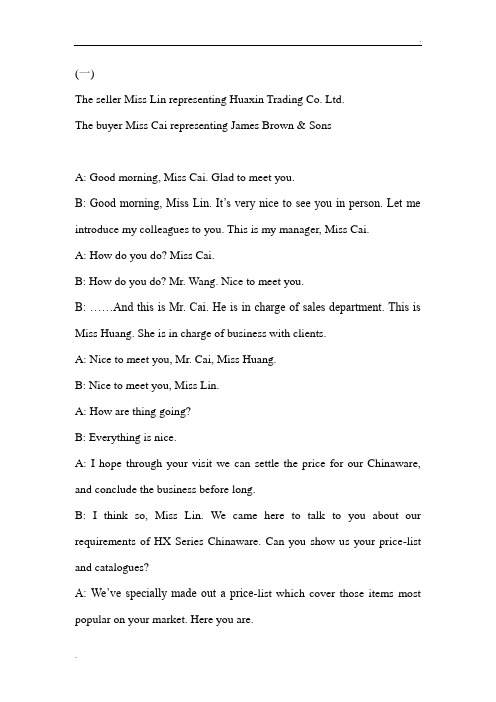
(一)The seller Miss Lin representing Huaxin Trading Co. Ltd.The buyer Miss Cai representing James Brown & SonsA: Good morning, Miss Cai. Glad to meet you.B: Good morning, Miss Lin. It’s very nice to see you in person. Let me introduce my colleagues to you. This is my manager, Miss Cai.A: How do you do? Miss Cai.B: How do you do? Mr. Wang. Nice to meet you.B: ……And this is Mr. Cai. He is in charge of sales department. This is Miss Huang. She is in charge of business with clients.A: Nice to meet you, Mr. Cai, Miss Huang.B: Nice to meet you, Miss Lin.A: How are thing going?B: Everything is nice.A: I hope through your visit we can settle the price for our Chinaware, and conclude the business before long.B: I think so, Miss Lin. We came here to talk to you about our requirements of HX Series Chinaware. Can you show us your price-list and catalogues?A: We’ve specially made out a price-list which cover those items most popular on your market. Here you are.B: Oh, it’s very considerate of you. If you’ll excuse me, I’ll go over your price-list right now.A: Take your time, Miss Cai.B: Oh, Mr. Wang. After going over your price-list and catalogues, we are interested in Art No. HX1115 and No. HX1128, but we found that your price are too high than those offered by other suppliers. It would be impossible for us to push any sales at such high prices.A: I’m sorry to hear that. You must know that the cost of production has risen a great deal in recent year while our prices of Chinaware basically remain unchanged. To be frank, our commodities have always come up to our export standard and the packages are excellent designed and printed. So our products are moderately priced.B: I’m afraid I can’t agree with you in this respect. I know that your products are attractive in design, but I wish to point out that your offers are higher than some of the quotations. I’ve received from your competitors in other countries. So, your price is not competitive in this market.A: Miss Cai. As you may know, our products which is of high quality have found a good market in many countries. So you must take quality into consideration, too.B: I agree with what you say, but the price difference should not be so big. If you want to get the order, you’ll have to lower the price. That’sreasonable, isn’t it?A: Well, in order to help you develop business in this line, we may consider making some concessions in your price, but never to that extent. B: If you are prepared to cut down your prices by 8%, we might come to terms.A: 8%? I’m a fraid you are asking too much. Actually, we have never gave such lower price. For friendship’s sake we may exceptionally consider reducing the price by 5%. This is the highest reduction we can afford. B: You certainly have a way of talking me into it. But I wonder if when we place a larger order, you’ll farther reduce your prices. I want to order one container of HX1115 and 438 sets of HX1128.A: Miss Cai, I can assure you that our price is most favourable. We are sorry to say that we cannot bring our price down to a still lower level. B: OK. I accept. Now, let’s talk about the terms of payment. Would you accept D/P? I hope it will be acceptable to you.A: The terms of payment we usually adopt are sight L/C.B: But I think it would be beneficial to both of us to adopt more flexible payment terms such as D/P term.A: Payment by L/C is our usual practice of doing business with all customers for such commodities. I’m sorry, we can’t accept D/P terms. B: As for regular orders in future, couldn’t you agree to D/P?A: Sure. After several smooth transactions, we can try D/P terms.B: Well, as for shipment, the soon the better.A: Yes. Shipment is to be made in April, not allowing partial shipment. B: OK. I see. How about packing the goods?A: We’ll pack HX1115 in carton of one set each, HX1128 in cases of one set each, two cases to a carton.B: I suggest the goods packed in cardboard boxes, it’s more attractive than cartons. Do you think so?A: Well. I hope the packing will be attractive, too.B: For transaction concluded on CIF basis, insurance is to be covered by the sellers for 110% of invoice value against WPA. Clash & Breakage and War Risk.A: This term less these goods should damage in transit. I agree with it. B: I’m glad we have brought this transaction to a successful conclusion and hope this will be the beginning of other business in the future. Let’s confirm these items we concluded at the moment.A: Yes. We concluded as follows: 542 sets of HX1115 at the price of USD 23.50 per set to be packed in cardboard boxes of one set each and to be shipped CIFC5 Toronto; 438 sets of HX1128 at the price of USD 14.50 per set to be packed in case of one set each, two cases to a cardboard box and to be shipped CIFC5 Toronto.B: All right. By the way, when can I expect to sign the S/C?A: Miss Cai, Would it convenient for you to come again tomorrowmorning. I’ll get the S/C ready tomorrow for your signature.B: That’s fine. See you tomorrow. Goodbye, Miss Lin.A: See you and thanks for coming, Miss Cai.(二)A The seller: Miss Li representing Huaxin Trading Company LimitedB The buyer: Mr. Huang representing James Brown & SonsA: Good morning, Mr. Huang. Glad to meet you.B: Good morning, Miss Li. Glad to meet you, too. It is my first time to visit Shanghai. Shanghai has been known to me as an interaction port city before I came here.A: We always take attention to establish business relations with the new clients in other countries. I wish we will have a good time this morning. B: I come here to visit you hoping to have a discussion with you on the purchase of your HX Series chinaware.A: Which Art. No. are you interested in?B: HX1115 and HX1128.A: Which price terms do you prefer, FOB, CFR, or CIF?B: CIF.A: The price of HX1115 is USD 24.19 per set CIF Toronto. The price of HX1128 is USD 14.93 per set CIF Toronto. It is understood that the above prices are net, without any commission.B: I am afraid it goes against the usual commercial practice not to allow acommission.A: We are prepared to grant you a 5% commission. 442 sets of HX1115 at the price of USD 24.68 per set CIFC5 Toronto; 338 sets of HX1128 at the price of USD 15.23 per set CIFC5 Toronto.B: I’m afraid your prices appear unworkable.A: I am assuring you that our prices are most favorable. A trial sale will unvoiced you of my words.B: Unless the prices could match with the market level, it is difficult to persuade customers to purchase with you. In order to conclude the transaction, I think you should reduce your price to USD 23.00 per set of HX1115. Will you consider cutting down your price to USD 14.20 per set of HX1128.A: As the raw material has advanced by 10% during the last few months and the prices are going up, owing to the rise in the cost of raw materials. We can’t accept this prices.B: I think it unwise for both of us to insist on his own prices. Can we each make some concession, say, the price of HX1115 is USD 23.50 per set CIFC5 Toronto; the price of HX1128 is USD 14.50 CIFC5 Toronto?A: If we accept your prices, we will not leave a little of margin of profit. B: I am afraid we have to call the whole deal off if you still insist on your original quotation.A: Well for friendship’s sake, we are prepared to make a 5% reduction ifyour order is big enough. Our minimum quantity is a 20’ container for each article.B: Our quantities are 542 sets of HX1115 and 438 sets of HX1128.A: OK.B: Shall we have a talk about terms of payment now?A: Our usual payment terms are by confirmed, irrevocable L/C payable by sight draft against presentation of shipping documents and to reach us 30 days before the month of shipment.B: To open an L/C will cause us a great deal of difficult. It’s expensive to open an L/C and ties up the capital of a company like ours. So it’s better for us to adopt D/P or D/A.A: L/C at sight is our usual payment terms.B: It is better for us to adopt D/P at sight than L/C at sight.A: We have never granted D/P terms to any new clients. So we hope you can accept the L/C terms. After several smooth transactions, we can try other terms.B: We can’t help it if you insist requiring payment by L/C at sight. By the way, what cover will you take out?A: The insurance is to be covered by us for 110% of invoice value against WPA Clash & Breakage and War Risks as per the Ocean Marine Cargo Clauses of PICC (1981.1.1).B: All right. How would you pack the goods?A: HX1115 is to be packed in cartons of one set each. HX1128 is to be packed in cases of one set each, two cases to a carton.B: I hope the packing will be attractive. Nice packing helps find a market. Please give special attention to the packing or the goods could be damaged in transit.A: All right.B: When is shipment to be made?A: Shipment is to be made before or on April 30, 1998.B: We have to point out that the goods are not allowing partial shipment. A: OK. By the way, what are the Ports of Shipment & Destination?B: Shanghai and Toronto.A: I’m glad we have brought this transaction to a successful conclusion and hope this will be the forerunner of other business in the future.B: All right. I accept your offer of 542 sets of HX1115 at the price of USD 23.50 per set, and 438 sets of HX1128 at the price of USD 14.50 per set. Shipment is to be made no later than April 30, 1998 after receipt of L/C and not allowing partial shipment. The Ports of Shipment & Destination are from Shanghai to Toronto. HX1115 is to be packed in cartons of one set each and HX1128 is to be packed in cases of one set each, two cases to a carton. The payment terms are by L/C at sight. Insurance is to be covered by you for 110% of invoice value against WPA Clash & Breakage and War Risks as per the Ocean Marine Cargo Clausesof PICC (1981.1.1).A: That’s right. I will get the Sales Confirmation re ady tomorrow for your signature. Would it be convenient for you to come again tomorrow morning?B: OK. We expect to find a good market for your goods and hope to place further and large orders with you in the near future. See you tomorrow morning.A: See you.。
商务价格谈判英文对话
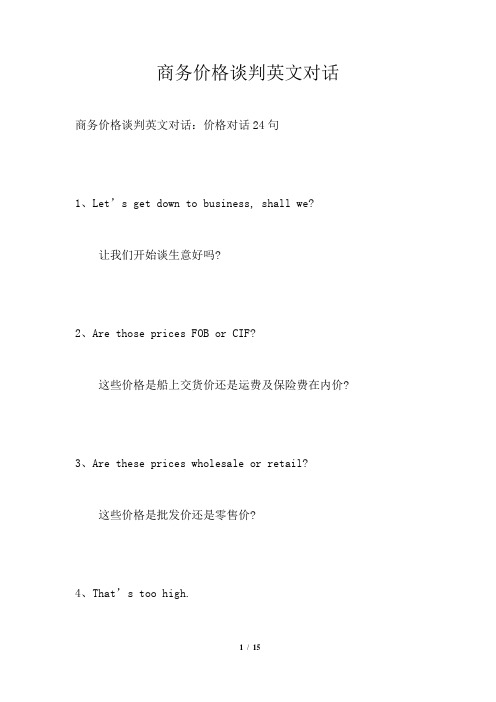
商务价格谈判英文对话商务价格谈判英文对话:价格对话24句1、Let’s get down to business, shall we?让我们开始谈生意好吗?2、Are those prices FOB or CIF?这些价格是船上交货价还是运费及保险费在内价?3、Are these prices wholesale or retail?这些价格是批发价还是零售价?4、That’s too high.价钱太高了。
5、Oh, no, this is the lowest price.噢,不,这是最低价。
6、Let us have your rock-bottom price.我们给你低价。
7、What’s the price range?价格范围是多少?8、They start at one hundred and fifty yuan and go up to two hundred yuan.它们以50元起价,至多到200元。
9、The price is quite reasonable.这价格相当合理。
10.The price is unreasonable.这价格高得不合理。
11、Can you make it a little cheaper? =Can you e down a little?=Can you reduce the price?你能不能算便宜一点?12、That sounds very impressive.那似乎非常好。
13、That sounds reasonable.那似乎非常好。
14、You’re offering us this product at 1800 yuan per unit-is that right?你提供我们的这种产品报价是每台1800元吗,对吗?15、We’d appreciate it if you could sell it to us for 1350 yuan per unit.如果你能以每台1350元的价格卖给我们,我们将不胜感激。
商务谈判技巧英文版(共3篇)(精简版)
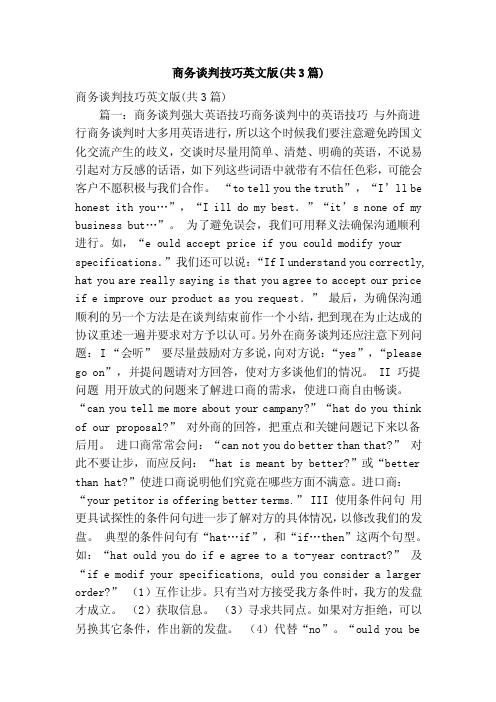
商务谈判技巧英文版(共3篇)商务谈判技巧英文版(共3篇)篇一:商务谈判强大英语技巧商务谈判中的英语技巧与外商进行商务谈判时大多用英语进行,所以这个时候我们要注意避免跨国文化交流产生的歧义,交谈时尽量用简单、清楚、明确的英语,不说易引起对方反感的话语,如下列这些词语中就带有不信任色彩,可能会客户不愿积极与我们合作。
“to tell you the truth”,“I’ll be honest ith you…”,“I ill do my best.”“it’s none of my business but…”。
为了避免误会,我们可用释义法确保沟通顺利进行。
如,“e ould accept price if you could modify your specifications.”我们还可以说:“If I understand you correctly, hat you are really saying is that you agree to accept our price if e improve our product as you request.” 最后,为确保沟通顺利的另一个方法是在谈判结束前作一个小结,把到现在为止达成的协议重述一遍并要求对方予以认可。
另外在商务谈判还应注意下列问题:I “会听” 要尽量鼓励对方多说,向对方说:“yes”,“please go on”,并提问题请对方回答,使对方多谈他们的情况。
II 巧提问题用开放式的问题来了解进口商的需求,使进口商自由畅谈。
“can you tell me more about your campany?”“hat do you think of our proposal?” 对外商的回答,把重点和关键问题记下来以备后用。
进口商常常会问:“can not you do better than that?” 对此不要让步,而应反问:“hat is meant by better?”或“better than hat?”使进口商说明他们究竟在哪些方面不满意。
商务谈判Business Negotiation
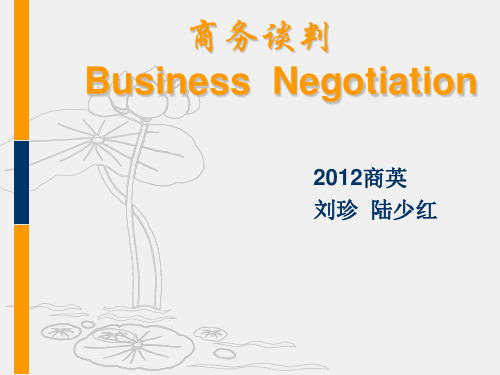
Wood:I see.But if you can ,please work out as soon as possible.
伍德:我明白,但如果可以的话,请尽可能地解决。
Simth:Thanks.We have finally reached a basic agreement on the problems that should be worked out.
史密斯先生:谢谢。对一些需要解决的问题我们终于基本上 达成了共识。
Wood:Both of us parties have made a great effort.
伍德:为此我们双方都做出了很大的努力
Simth:That is ture .It is time for us to sign the contract.
史密斯先生:是的,该是我们签合同的时间了。
Wood:I have been looking forward to this moment. I will fax the counter-signed contract to you later .Each of us has two formal copies of the contract,one in Chinese and one in English.Would you keep these two copies?
史密斯先生:谢谢。对一些需要解决的问题我们终于基本 上达成了共识。
Smith:Yes,that is ok.I understand your position.
史密斯先生:是的,没问题。可以理解。
Wood:That is all right.But our company must test the website each month,of course,this can give you the best level of service.
谈判技巧英文作文

谈判技巧英文作文英文:Negotiation is a crucial skill in both personal and professional life. It is the art of reaching an agreement through discussion and compromise. As a professional negotiator, I have learned several key skills and strategies that have helped me succeed in various negotiations.First and foremost, it is important to prepare thoroughly before entering into a negotiation. This includes researching the other party, understanding their needs and priorities, and identifying potential areas of compromise. For example, when I was negotiating a business deal with a potential client, I spent time researching their company and industry to understand their challenges and goals. This allowed me to tailor my proposal in a way that addressed their specific needs, making it more likely for them to agree to my terms.Another important skill in negotiation is active listening. It is crucial to truly understand the other party's perspective and concerns in order to find a mutually beneficial solution. In one negotiation, I encountered a situation where the other party was hesitant to agree to my terms. Instead of pushing my agenda, I took the time to listen to their concerns and address them, which ultimately led to a successful agreement.Furthermore, it is essential to remain calm and composed during a negotiation, even when faced with challenges or resistance. This demonstrates confidence and control, which can positively influence the outcome of the negotiation. For instance, in a salary negotiation with a potential employer, I remained calm and confident while discussing my value to the company, which ultimately resulted in a higher salary offer than initially proposed.In addition to these skills, it is important to be adaptable and flexible during negotiations. Sometimes, unexpected obstacles or new information may arise,requiring a shift in strategy. In a recent negotiation, I encountered a sudden change in the other party's demands. Instead of becoming rigid in my position, I adapted my approach and proposed alternative solutions, ultimately reaching a successful agreement.Overall, negotiation is a complex and dynamic process that requires a combination of skills, strategies, and a deep understanding of human psychology. By mastering these skills and continuously refining my approach, I have been able to achieve successful outcomes in various negotiations, both personally and professionally.中文:谈判是人生中至关重要的技能,无论是在个人生活还是职业生涯中都是如此。
国际商务谈判(英文版)Chapter 5 Strategies and Tactics
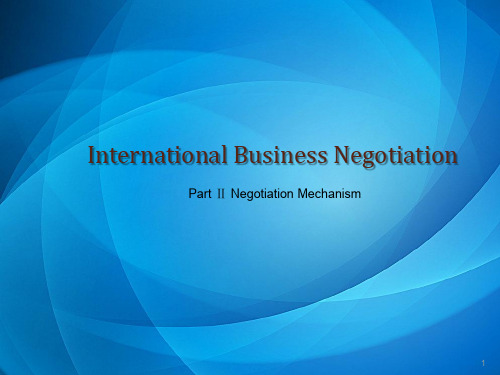
(3) Convincing the other party's supporters to block the other party's operation;
(4) Convincing the other party of the hopelessness of trying to continue on their own.
your offer.9源自②Dependence The most effective and often explored methods to this end are:
(1) Reducing, delaying or withholding services or resources the other party hopes to attain;
7
Factors Causing the Changes of Negotiating Power
Relations of the three factors with the power changes are expressed in the following equation:
P(A~B) = MB×"DB:A" /"SB" -MA×"DA:B" /"SA"
(4) One party has ability to use expert counsel,
persuasion, communication and legal,
historical or moral precedents to gain access to
国际商务谈判(英文)chapter10 Negotiation Strategies

(14)Straw Man
(15)Turnabout
(16)Use of Power
8
10.3.2The Accommodation Strategy
(1)Face-Saving (2)Identification (3)Take the Lead Oar (4)Take Reasonable Actions
3
Contents
1 Improving Negotiation Skills 2 Strategic Considerations 3 Developing Your Negotiation strategies
4
10.1 Improving Negotiation Skills • “Strategy” is considered as comprising the
12
Thanks!
13
11
10.3.5 The Avoidance Strategy (1)Negotiate Money Issues First (2)Negotiate Non-Money Issues First (3)Refuse to Combine Negotiation of Related
Disputes (4)Walk Out of the Negotiation (5)Withdraw an Issue (6)Switching Strategies
L/O/G/O
国际商务谈判(英文)chapter10 Negotiation Strategies
Chapter10 Negotiation Strategies
2
Teaching Objectives
After studying this module, you should be able to know: • 1. Strategic considerations • 2. negotiation strategies; • 3. choices of strategy; • 4. how to develop your own negotiation style
国际商务谈判(英文)chapter6 Counter-offer and its strategy

(7)Look before you leap.
(8)Do not make it too easy for the other party to gain what he wants.
(9)Take back an improper and ill-conceived concession .
(10)Let the other party do it first and then follow suit.
Competition.
Knowledge.
Time Constraints.
Bargaining Skills.
Importance of the Contract to Each Party. 6
6.2.2 How to set a price range of a counter offer?
6.3.2 general principle for makin concessions
(1)Do not make a senseless concession. (2)Do not make concessions blindly. (3)Seize the big “fish” and release the small one. (4)Choose the right time.
5
6.2 bargaining tactics
商务谈判对话英文版
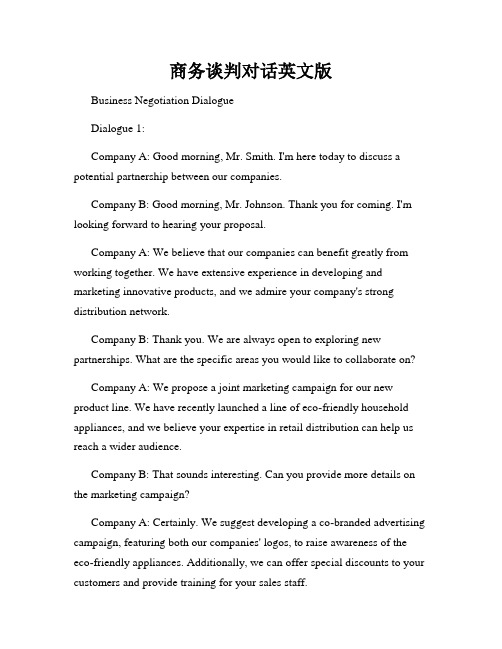
商务谈判对话英文版Business Negotiation DialogueDialogue 1:Company A: Good morning, Mr. Smith. I'm here today to discuss a potential partnership between our companies.Company B: Good morning, Mr. Johnson. Thank you for coming. I'm looking forward to hearing your proposal.Company A: We believe that our companies can benefit greatly from working together. We have extensive experience in developing and marketing innovative products, and we admire your company's strong distribution network.Company B: Thank you. We are always open to exploring new partnerships. What are the specific areas you would like to collaborate on?Company A: We propose a joint marketing campaign for our new product line. We have recently launched a line of eco-friendly household appliances, and we believe your expertise in retail distribution can help us reach a wider audience.Company B: That sounds interesting. Can you provide more details on the marketing campaign?Company A: Certainly. We suggest developing a co-branded advertising campaign, featuring both our companies' logos, to raise awareness of the eco-friendly appliances. Additionally, we can offer special discounts to your customers and provide training for your sales staff.Company B: I see the potential in this collaboration. However, we would need to evaluate the financial feasibility. What are your expectations regarding the costs involved?Company A: We understand the importance of cost considerations. We propose a cost-sharing model where both companies invest in the marketing campaign based on their respective market share. We can provide a detailed cost breakdown for your review.Company B: That seems fair. We will need some time to analyze the proposal and discuss it internally. Can we schedule a follow-up meeting next week to further discuss the financial aspects?Company A: Absolutely. We can also provide additional materials and case studies that showcase the success of our previous collaborations. Let's meet next Wednesday at 2:00 p.m. Does that work for you?Company B: Perfect. I will make sure our team is prepared for the meeting. Thank you for your time today.Company A: Thank you for considering our proposal. We look forward to discussing the details further next week.Dialogue 2:Company A: Good afternoon, Mr. Wang. I'd like to discuss the possibility of a joint venture between our companies.Company B: Good afternoon, Mr. Jones. I'm interested in exploring this opportunity. Please tell me more about your proposition.Company A: We have noticed that your company has a strong presence in the Asian market, and we believe that together we can expand our reach and increase market share.Company B: I appreciate your interest. Could you provide some information about the specific industry or sector you have in mind?Company A: Certainly. We propose collaborating in the renewable energy sector, specifically in the development and production of solar panels. We have advanced technology in this field, and with your established distribution channels, we can effectively penetrate the market.Company B: Solar energy is indeed a promising industry. How do you suggest we structure this joint venture?Company A: We suggest a 50/50 partnership, where both companies invest equally in capital, resources, and expertise. This way, we can share risks and rewards.Company B: That sounds reasonable. Besides financial contributions, what other support can each company provide?Company A: In addition to financial investments, we can contribute our research and development capabilities, as well as our expertise in manufacturing high-quality solar panels. Your company's distribution channels and local market knowledge would be valuable assets to the joint venture.Company B: I see potential synergies in this collaboration. However, we need to carefully assess the costs and potential returns. Can you provide a detailed financial projection?Company A: Of course. We will prepare a comprehensive financial analysis, including investment requirements, projected revenue growth, and estimated return on investment. We can discuss these details in our next meeting.Company B: That would be great. Let's meet again next Monday to review the financial projections and discuss any further questions or concerns.Company A: Excellent. We will be well-prepared and ready to address any additional inquiries. Thank you for your time and consideration.Company B: Thank you for presenting this opportunity. I look forward to our follow-up meeting.In conclusion, business negotiation dialogues play a crucial role in establishing partnerships and reaching agreements. They require effective communication, clear proposal presentations, and a willingness to find common ground. These dialogues provide a framework for companies to explore collaboration opportunities, discuss potential benefits, address concerns, and ultimately work towards mutually beneficial agreements.。
国际商务谈判英文版第三版
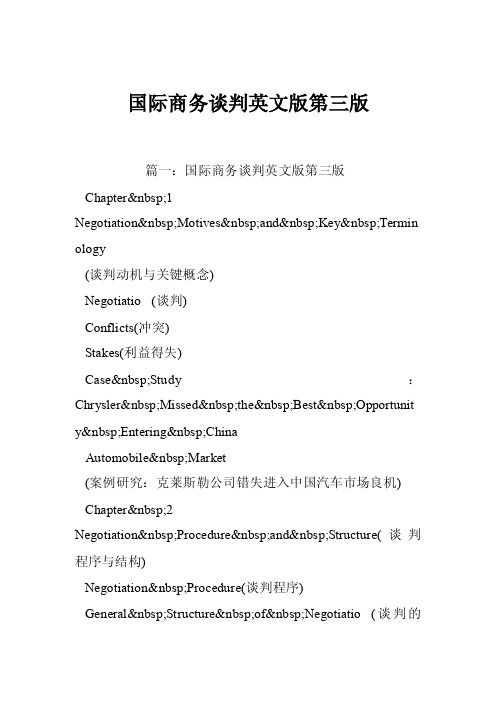
国际商务谈判英文版第三版篇一:国际商务谈判英文版第三版Chapter 1Negotiation Motives and Key Termin ology(谈判动机与关键概念)Negotiatio(谈判)Conflicts(冲突)Stakes(利益得失)Case Study:Chrysler Missed the Best Opportunit y Entering ChinaAutomobile Market(案例研究:克莱斯勒公司错失进入中国汽车市场良机) Chapter 2Negotiation Procedure and Structure(谈判程序与结构)Negotiation Procedure(谈判程序)General Structure of Negotiatio(谈判的一般结构)Structure of Business Negotiatio(贸易谈判结构)Simulation:An Economic Recession(模拟谈判:一次经济衰退)Case Study I:The Principle of Complementary Con cession(案例研究Ⅰ:对等性让步原则)Case Study II:Sino-US Negotiatio on Intellectual Property Right Protection(案例研究Ⅱ:中美知识产权谈判)Chapter 3 Negotiation Lubrication(谈判润滑剂)Target Decision(设定谈判目标)Collecting Information(信息调研)Staffing Negotiation Teams(配备谈判组成员) Choice of Negotiation Venues(谈判地点的确定)Simulation:Silk Selling(模拟谈判:丝绸销售) Case Study:Cases Showing Importance of Pre-ne gotiation Preparation(案例研究:谈判前准备工作的重要性)Chapter 4 Win-win Concept(双赢原则) Traditional Concept(传统理念)Introduction of Win-win Concept--a&nbs p;Revolution in Negotiation Field(赢一赢理念的引入——谈判界的一场革命)How Can Both Sides win(怎样实现双赢)Simulation:Financial Leasing Negotiation (模拟谈判:融资租赁谈判)Case Study:Argument between the Developing C ountries andDeveloped Countries(案例研究:发展中国家与发达国家的争论)Chapter 5 Collaborative Principled Negotiation(合作原则谈判法)Collaborative Principled Negotiation and Its Four Components(合作原则谈判法及其四个组成部分)Separate the People from the Problem(对事不对人)Focus on Interests But Not P ositio(着眼于利益而非立场)Invent Optio for Mutual Gain(创造双赢方案)Introduce Objective Criteria(引入客观评判标准) Simulation:Hotel Selling(模拟谈判:旅馆销售) Case Study:Company Policy(案例研究:公司政策)Chapter 6 Law of Interest Di stribution(利益分配法则)Needs Theory(需求理论)Application of the Needs Theory& nbsp;in Negotiation(需求理论在谈判中的应用)Three Levels of Interests at t he Domestic Level(国内谈判的三层利益)Law of Two-Level Game(双层游戏规则) Simulation:A Dam on the River(模拟谈判:河上建坝纠纷)Case Study:US-Japan Negotiatio on Semiconducto (案例研究:美日半导体谈判)Chapter 7 Negotiating Power and& nbsp;Related Facto(谈判力及相关因素) Negotiating Power and Sources of Negotiating Power(谈判力及谈判力的来源)Facto Causing the Changes of&n bsp;Negotiating Power(影响谈判力变化的因素)Application of Power Tactics(谈判力策略的应用)Estimating Negotiating Power(测量谈判力) Simulation:Negotiation on Oil Contract (模拟谈判:石油合同谈判)Case Study:Law—a Source of Negotiating Power (案例研究:法律——谈判力的一个来源)Chapter 8 Law of Trust(信任法则) Trust and Its Interpretation(信任及其解释)How to Decide a Pe on Tru sts or Is Trusted?(怎样决定一个人信任他人或者被别人信任) Determinants Affecting a Pe on”s Trustful or Mistrustful Behavior(影响一个人信任或不信任行为倾向的决定因素)Effects of Trust(信任的效应)Suggestio of Enhancing Mutual T rust(如何增进相互信任)Simulation:Market Research for a New Pr oduct(模拟谈判:新产品的市场调研)Case Study:Dilemma of the Management(案例研究:经理层的尴尬)Chapter 9 Pe onal Styles vs.Neg otiation Modes(谈判者性格类型与谈判模式)Negotiato “ Pe onal Styles(谈判者的性格类Negotiato “ Pe onal Styles and A C Model(个人性格类型与AC模型)Pe onal Styles vs.Negotiation Modes (性格类型与谈判模式)Application of Pe onality Checks(性格测试在谈判中的应用)Simulation:Global Corporation VS.Hi—tech Corporat ion(模拟谈判:全球公司与高科技公司)Case Study:Shopping in Manhattan (案例研究:在纽约曼哈顿购物)Chapter 10Game Theory and Negotiation Applic ation(博弈论及其在谈判中的应用)Game Theory,Its Assumptio and Rules(博弈论及其基本假设和规则)Co equences and the Matrix Displ(结果和矩阵排列)The Prisoner”s D ilemma(囚徒困境)Direct Determinants of the Coordin ation Goal(合作目标的直接决定因素)Simulation:China and Japan in Iron 0re&n bsp;Negotiation(模拟谈判:中国与日本铁矿石谈判中的博弈)Case Study:Making a Decision under Uncertainty (案例研究:不确定条件下的决策)Chapter 11 Distributive Negotiation  ;and Price Negotiation(两分法谈判与价格谈判)Distributive Negotiatio(两分法谈判)Price Negotiation and Negotiation Zone(价格谈判和谈判区间)Simulation:Sales for a Second-hand Car(模拟谈判:二手车销售)Case Study:An Example of the Use of&nb sp;Cost Analysis(案例研究:一个运用成本分析法的例子)Chapter 12 Complex Negotiatio(复杂谈判)Complex Negotiatio and Their Pr operties(复杂谈判及其特点)Involvement of Third Parties(第三方的参与)Coalition,Multi—party Negotiation(多方参与的谈判和谈判联合体)Simulation:Green Bank(模拟谈判:格林银行) Case Study:Iacocca Rescuing Chrysler (案例研究:艾柯卡拯救克莱斯勒公司)Chapter 13Culture Patter vs.Negotiation Patter(文化模式与谈判模式)Definition of Culture(文化的定义)Culture Patter(文化模式)Hofstede Cultural Value Study(霍夫斯泰德的文化价值研究)Simulation:Cultural Conflicts in the Negotiation of the World Bank Rural&nbs p;Water Supply Project(模拟谈判:世界银行改水项目谈判中的文化冲突)Case Study:Southern Candle”s Tour to France (案例研究:南部蜡烛公司的法国之行)篇二:国际商务谈判英文版第三版 However, some nego-tiators do not want to give up easily because the failure of the negotiation means neithercan have their interests realized. There can be another way Out. negotiating partiesmake efforts and explore alternatives to the options put forward before. A capable nego-tiator can always exhibit great initiatives and high ability by coming up with new op-tions and constructive suggestions which show the concern to the interests of both pari-ties. Quite often the final agreement of negotiations is reached based on several options. Roger Fisher and William Ury put forward an idea of “best alternative to a negotia-ted agreement (BATNA)” in their work Getting to Yes--Negotiating Agreement with-out Giving in. BATNA refers to your last choice between the conditions of the otherside and the opportunity for other better results. An example can help understand thepoint better. When you feel dissatisfied with your present salary and want to ask yourboss to raise your salary, what do you hope to put in your pocket? Is it a gun or a joboffer from another company that is a strong competitor to your present company? To find a BATNA is not an easy task. It requires a lot of investigation, considera-tion and comparison between your own options and options of other parties. Researchshows most of negotiators are ignorant of the importance of BATNA because they areoveroptimistic and overconfident. In fact most of important negotiations can not find asolution from one option. Negotiations without alternative options often end with failure. The following is an example of how to make an assessment of BATNA. Step One: Brainstorm alternatives. Assuming that a company is negotiating withits overseas distributor on commission fee. The negotiator should brainstorm to gener-atealternatives if the overseas distributor refuses to accept 6% commission on sales.The alternatives should be realistic and based on reliable information. The negotiatormay consider distributing in the overseas market through a home-based company. Asecond one may be to utilize the Internet to participate in the overseas market. A thirdalternative may be to increase the commission of the distributor.书摘()版权页: However, some nego-tiators do not want to give up easily because the failure of the negotiation means neithercan have their interests realized. There can be another way Out. negotiating partiesmake efforts and explore alternatives to the options put forward before. A capable nego-tiator can always exhibit great initiatives and high ability by coming up with new op-tions and constructive suggestions which show the concern to the interests of both pari-ties. Quite often the final agreement of negotiations is reached based on several options.Roger Fisher and Will iam Ury put forward an idea of “best alternative to a negotia-ted agreement (BATNA)” in their work Getting to Yes--Negotiating Agreement with-out Giving in. BATNA refers to your last choice between the conditions of the otherside and the opportunity for other better results. An example can help understand thepoint better. When you feeldissatisfied with your present salary and want to ask yourboss to raise your salary, what do you hope to put in your pocket? Is it a gun or a joboffer from another company that is a strong competitor to your present company?To find a BATNA is not an easy task. It requires a lot of investigation, considera-tion and comparison between your own options and options of other parties. Researchshows most of negotiators are ignorant of the importance of BATNA because they areoveroptimistic and overconfident. In fact most of important negotiations can not find asolution from one option. Negotiations without alternative options often end with failure. The following is an example of how to make an assessment of BATNA.Step One: Brainstorm alternatives. Assuming that a company is negotiating withits overseas distributor on commission fee. The negotiator should brainstorm to gener-ate alternatives if the overseas distributor refuses to accept 6% commission on sales.The alternatives should be realistic and based on reliable information. The negotiatormay consider distributing in the overseas market through a home-based company. Asecond one may be to utilize the Internet to participate in the overseas market. A thirdalternative may be to increase the commission ofthe distributor.作者简介() 白远,教授,硕士生导师,现任教于北京第二外国语学院国际经济贸易学院,主讲国际商务谈判、当代世界经济、国际贸易和国际经济合作等课程(前三门为全英语授课)。
商务谈判英文版

2.The Negotiators Should Select Those Issues Rele vant to the Particular Negotiation
This is a matter of obtaining an understanding of so me of the points referred to in the above mentioned section so that the negotiators can recognize both t he degree of their importance and the extent to whi ch they are interrelated.
The brief should: 1. define the negotiating objective in terms of the
major issues to be discussed. 2. state the minimum acceptable level for each of t
The business system: business conduction; significance given to contract, roles of profession al advisers (wyer); negotiation proceeding (e.g. first the technical and then the commercial. How to make concession?); and the counterpart of the negotiation (e.g. agency or the operating c ompany) and etc.
商务谈判的技巧英文
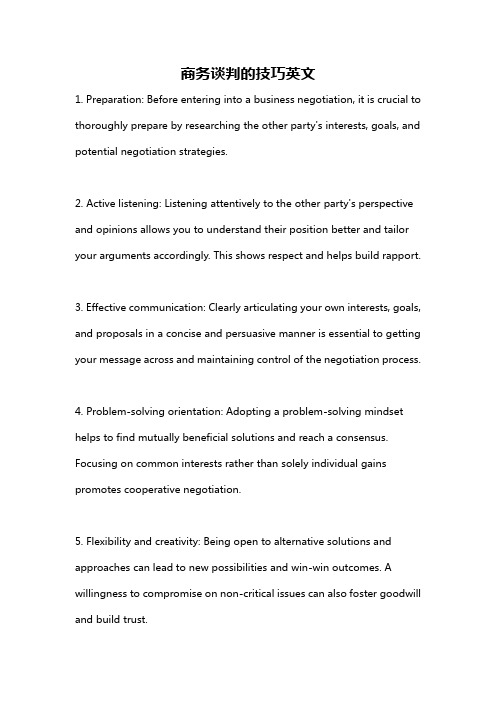
商务谈判的技巧英文1. Preparation: Before entering into a business negotiation, it is crucial to thoroughly prepare by researching the other party's interests, goals, and potential negotiation strategies.2. Active listening: Listening attentively to the other party's perspective and opinions allows you to understand their position better and tailor your arguments accordingly. This shows respect and helps build rapport.3. Effective communication: Clearly articulating your own interests, goals, and proposals in a concise and persuasive manner is essential to getting your message across and maintaining control of the negotiation process.4. Problem-solving orientation: Adopting a problem-solving mindset helps to find mutually beneficial solutions and reach a consensus. Focusing on common interests rather than solely individual gains promotes cooperative negotiation.5. Flexibility and creativity: Being open to alternative solutions and approaches can lead to new possibilities and win-win outcomes. A willingness to compromise on non-critical issues can also foster goodwill and build trust.6. Time management: Maintaining control over the negotiation time frame prevents unnecessary delays and keeps the process focused. Establishing clear time boundaries for each agenda item helps manage the negotiation effectively.7. Building relationships: Investing time in building a positive relationship with the other party can enhance trust and facilitate smoother negotiations. Demonstrating empathy, respect, and professionalism can contribute to long-term successful business partnerships.8. Knowing your limits: Identifying your non-negotiable positions and boundaries is essential to avoid making concessions that may harm your interests or goals. Understanding your BATNA (Best Alternative To a Negotiated Agreement) helps determine your limits during the negotiation.9. Emotional intelligence: Being aware of your emotions and managing them effectively during the negotiation can prevent impulsive decision-making and maintain a calm and professional demeanor.10. Continuous learning and improvement: Reflecting on pastnegotiations and seeking feedback helps refine your negotiation skills over time. Being open to learning from both successes and failures contributes to ongoing growth as a negotiator.。
商务英语口语:45个国际商务谈判术语

商务英语口语:45个国际商务谈判术语商务英语有很多的发展方向,比如翻译、外贸、教师等等很多选择。
不过,不管你希望往哪个方向去发展,一些国际通用的谈判知识,还是可以先了解的。
下面我们就来看下,专业的商务谈判中,各种技巧及原则的英文释义吧!1、Bargaining讨价还价petitive, win-lose situations.2、Selective perception 选择性感知When the perceiver singles out certain information that supports a prior belief and filters out information that does not confirm that belief.3、Intangibles无形因素intangible factors are the underlying psychological motivations that may directly or indirectly influence the parties during a negotiation.4、Interdependent相互依赖when the parties depend on each other to achieve their own preferredoute they are interdependent.5、Negotiator’s dilemma谈判者的困境the choice of whether to pursue a claiming value strategy is described as the “negotiator’s dilemma”.6、initial offer最初报价the first number the buyer will e to the seller.7、petitive situation竞争性情形:when the goals of two or more people are interconnected so thatonly one can achieve the goal, this is petitive situation, also known as a zero-sumor distributive situation,in which “individuals are so linked together that there is a negative correlation between their goal attainments”.8、Mutual-gainssituation相互获益情形: When parties’goals arelinked so that one person’s goal achievement helps others to achieve theirgoals, it is a mutual-gains situation,also known as a non-sum or integrative situation.9、BATNA达成谈判协议的最佳选择an acronym for best alternative to a negotiated agreement.10、Thedilemma of honesty诚实困境it concerns how much of the truth to tell the other party.11、Thedilemma of trust信任困境it concerns how much should negotiators believe what the other party tells them.12、Distributive bargaining分配式谈判accepts the fact that there can only be one winner given the situation and pursues a course of action to be that winner.13、Integrative bargaining共赢争价attempts to find solutions so both parties can do well and achieve their goals.14、Claimvalue主张价值to do whatever is necessary to claim the reward, gain the lion’s share, or gain the largest piece possible.15、Createvalue创造价值to find a way for all parties to meet their objectives, either by identifying more resources or finding unique ways to share and coordinate the use of existing resources.16、Stereotypes心理定势is a very mon distortion of the perceptual process. It occurs when one individual assigns attributes to anothersolely on the basis of the other’s membership in a particular social or demographic category.17、Contending争夺战略actors pursuing the contending strategy pursue their own outes strongly and show little concern for whether the other party obtains his or her desired outes.18、Yielding屈服战略actors pursuing the yielding strategy show little interest orconcern in whether they attain their own outes, but they are quite interested in whether the other party attains his or her outes.19、Inaction不作为战略actors pursuing the inaction strategy show little interest in whether they attain their own out-es, as well as little concern about the other party obtains his or her outes.20、Problem solving解决问题战略actors pursuing the problemsolving strategy show high concern for attaining their own outes and high concern for whether the other.21、target point目标点the point at which negotiator would like toconclude negotiations.22、resistance point拒绝点a negotiator’s bottom line, the mostthe buyer will pay or the smallest amount the seller will settle for.23、a positive bargaining range积极的谈判空间the buyer’s resistance is above the the seller’s, and the buyer minimally willing to pay morethan the seller is minimally willing to sell for.24、Reciprocity互惠主义when you receive sth from another person, you should respond in the future with a favor in return.25、The winner’s curse赢家的诅咒the tendency of negotiators, particularly inan auction setting, to settle quickly on an item and then subsequently feel disfort about a negotiation win that es too easily.26、Process-basedinterests基于谈判过程的利益related to how the negotiators behave as they negotiate.27、indirect assessment间接估计determining what information an individual likely used to set targetand resistance point and how he or she interpreted this information.28、ive presentation选择性表述negotiators reveal only the facts necessary to support their case.29、Pareto efficient frontier帕累托有效边界the claiming value line is pushed towards the upper right-hand side to the fullest extent possibleby creating value, and the line is called the Pareto efficient frontier.30、shared goal共享目标the goal that both parties work toward but that benefits each party differently.31、joint goal联合目标the goal thatinvolves individuals with different personal goals agreeing to bine them in a collective effort.32、Endowment effect捐赠效应The tendency to overvalue something you ownor believe you possess.33、Relationship-basedinterests基于双方关系的利益tied to the current or desired future relationship between theparties.34、Resistance point拒绝点a resistance point is the place where you decide that you should absolutely stop the negotiation rather than continue because any settlement beyond this point is not minimally acceptable.35、Alternatives可替代的选择other agreements negotiators couldachieve and still meet their needs.36、Target point目标点one realistically expects to achievea settlement and the asking price, representing the best deal one can hope toachieve.37、Halo effects晕轮效应rather than using a person’s group membership as a basis for classification, however,halo effects occur when people generalize about a variety of attributes basedon the knowledge of one attribute of an individual.38、Projection投射效应When people assign to others the characteristics or feelings that they possess themselves.39、Mythical fixed-pie beliefs固定蛋糕观念those who believe in the mythical fixed-pie assume there is no possibility for integrative settlements and mutually beneficial trade-offs, and they suppress efforts to search for them.40、Anchoring and adjustment基准调节cognitive biases in anchoring and adjustmentare related to the effect of the standard (or anchor)against which subsequent adjustments are made during negotiation.41、Issue framing and risk谈判框架的制定方式与风险the way a negotiation is framedcan make negotiators more or less risk averse or risk seeking.42、Availability of information信用的可用性in negotiation, the availabilitybias operates when information that is presented in vivid, colorful, orattention-getting ways bees easy to recall, and thus also bees centraland critical in evaluating events and options.43、The law of small numbers小数法则in decision theory, the law of small numbersrefers to the tendency of people to draw conclusions from sle sizes. Innegotiation, the law of small numbers applies to the way negotiator learn and extrapolate from their own experience.44、Self-serving biases感知错误The tendency to overestimate the causal roleof personal or internal factors and underestimate the causal role of situationalor external factors, when explaining another person’s behavior.45、Ultimatum最后通牒an ultimatum is an attempt to induce pliance or force concessions from a presumably recalcitrant opponent.。
- 1、下载文档前请自行甄别文档内容的完整性,平台不提供额外的编辑、内容补充、找答案等附加服务。
- 2、"仅部分预览"的文档,不可在线预览部分如存在完整性等问题,可反馈申请退款(可完整预览的文档不适用该条件!)。
- 3、如文档侵犯您的权益,请联系客服反馈,我们会尽快为您处理(人工客服工作时间:9:00-18:30)。
商务谈判技巧英文篇一:论商务英语谈判技巧成都大学毕业设计(论文)题目:作者姓名:指导教师:所在学院:外国语学院答辩日期:On the Skills of Commercial English 邹长勤学号:王慧职称:讲师专业:英语2007 年 6 月 6 日论商务英语谈判技巧摘要:商务英语谈判中有许许多多谈判技巧,此论文主要目的在于突出商务谈判技巧中的语言技巧。
在正文中,首先分析了谈判的必要程序,然后进行谈判语言技巧的研究。
在谈判的语言技巧中有很多重要的技巧。
为了在谈判中获胜,有四个技巧不容忽视——交流的技巧,恭维的技巧,间接表达的技巧和说服的技巧。
通过很好的掌握并有效地运用这些技巧,可以达到令人满意的结果并和对手建立起和谐的友谊,得到长远合作的机会。
商务谈判是一个充满冲突和竞争的过程,如果双方都想个别利益最大化,那么冲突就会随时由此发生,如果他们坚持己见,将导致谈判没有结果且有害无益。
此时,谈判者就会想办法借助很多谈判技巧,所以目的性的语言技巧得以运用,作为一位语言运用者兼谈判者必须有意识无意识地使自己的语言随时适应不断变化的形势。
在成功谈判者的谈判过程中,你可以了解到他们不只把语言当作畅谈的工具,而是把语言当作一种非常有效的技巧。
他们那恰如其分的表达以及熟练的语言技巧能有效地增强谈判者间的相互信任和相互理解,这样就增加谈判成功的机会,以便最终能达成一个令人欣喜,双赢的结果。
关键词:商务谈判;语言;沟通;语言技巧On the Skills of Commercial English NegotiationAbstract :There are hundreds of negotiation skills in the commercial English negotiation; this paper mainly attempts to highlight the language skills. In the context, I firstly analyze the necessary processes about commercial English negotiation, and then come into the study of the language skills; there are many important aspects of language skills in commercial English negotiation. To make commercial English negotiation successful, these four aspects —skills of communication, skills of compliments, skills of applying indirectness and skills of persuasive can never be ignored. Good commanding and effect using of the language skills can help you to achieve a satisfactory result, establish harmonious relationships and gain further cooperationwith the counterpart.Commercial English negotiation is a process full of conflicts and arguments. Conflicts would appear consequently when two parties try to maximize their individual interests. If they persist in their own opinions, the negotiation will become unproductive, detrimental to the arrival of agreements. Understandably, negotiators would employ various techniques at this time. Then the purposeful use of language comes in. As a language user as well as a negotiator, you must consciously or unconsciously adapt your language to meet the need of perpetual changing situation. In negotiating, you can see a successful negotiator not only takes language as a communicative tool, but also as a very useful skill. Their proper and skillful use of language skills can effectively enhance the mutual trust and understanding among negotiators, so as to increase the odds fornegotiation success, and reach a happy result which will benefit and satisfy both sides.Key words: Commercial Negotiation; Language; Communication; Language SkillsContents摘要.................................................................................. ....................... ............I 关键字.................................................................................. ....................... . (I)Abstract ............................................................................................ ................II Key words................................................................................................. . (II)Introduction……………………………….............................................. ....... ...............1 1. Negotiation.......................................................................................... (1)Stages of negotiation (2)Pre-negotia tion (2)Face-to-face negotiation (3)Post-negotiation (4)Seven steps of negotiation (4)Types of Negotiation……………………………… (5)2. Language in negotiation (6)power of language (6)The Power of body language (7)Language‘s role in creating meaning (9)Communication ........................................................................................ . (10)The importance of communication (11)3. Language approach in negotiation ……………………………… (12)Listening and Questioning skill (12)Listening (12)Questioning (13)skills of compliments (14)Choices of commendatory words.............................................. . (15)of Compliments between Chinese and English (15)skills of applying indirec tness (16)Reasons to apply (16)Choices of proper words (16)Ways of expressing (17)persuasive skill in negotiation ................................................ (17)4. How to reach agreement ............................................................... . (20)Conclusion ........................................................................................... (21)Acknowledgement................................................................................. (23).............................................. ....... .. (24)On the Skills of Commercial English Negotiation IntroductionCommercial English negotiations in China have been carried out far more frequently with the development of economy. In an increasingly competitive and dynamic business environment, negotiation is critically important to the success and, ultimately to the survival of companies. So nowadays the ability to negotiate is one of the most valuable skills you can bring to any job. Negotiation is about both sides reaching a good outcome, or at least one they feel they can live with and have contributed to and it will almost certainly involve compromise on both sides. Under such circumstances, the business traders need to master and constantly improve theirnegotiating capabilities and skills to achieve a better result through negotiation.To some extent, commercial negotiation can be considered as a battle fought against negotiators. In commercial English negotiations, negotiators must obey the trade rules, negotiate process and meanwhile maintain their own benefits. However in negotiating, both parties involved will endeavor to win the most benefits while maintaining cooperation with each other. Therefore it is necessary to adopt the appropriate language skills .Among them,compliments and persuasion are the most commonly used skills that contribute to a successful commercial negotiation.Negotiation is basically the verbal communication, and sometimes it is a play of language. Negotiators need to know better about the language skills, such as compliments, persuasive skills, and how toexpress indirectly to avoid conflicts, so as to make the negotiation succeed.Ideally, commercial negotiations should be founded on mutual trust and respect. They should be conducted within a problem-solving atmosphere, with sufficient time to tackle all issues.1. NegotiationNegotiation is a basic human activity. It is a basic means of getting what you want from others, it is a process we undertake in everyday activities to manage our relationship, and a process through which parties move from their initially divergent篇二:商务谈判与推销技巧英文重庆工商大学重点课程《商务谈判与推销技巧教案》教案(适应:高职专科)重庆工商大学应用技术学院二〇〇六年八月目录绪论???????????????????????????3 第一章商务谈判概论??? ?????????????? 4 第二章商务谈判模式与风格............................... ..9 第三章商务谈判准备...................................... 13 第四章第五章第六章第七章第八章第九章第十章第十一章第十二章商务谈判各阶段策略............................... 20 商务谈判技巧.................................... 27 推销概论....................................... 29 推销理论与模式.................................... 40 如何寻找客户.................................... 51 接近客户和洽谈技巧. (65)如何处理客户异议.................................69 成交和讨债实务...................................... 77 推销管理.. (86)《商务谈判与推销技巧》教案一、课程概述1、课程代码2、课程名称(1)中文名:商务谈判与推销技巧(2)英文名:negotiation &selling skills3、课程管理院(系)及教研室:应用技术学院市场营销应用技术教研室4、课程的性质及适用专业、层次:营销与策划高职专科、会展策划与管理高职专科专业必修课程5、课程学时和学分数(1)学时:共48学时。
